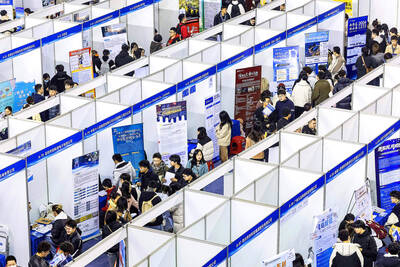Wall Street closed higher and the NASDAQ reached an all-time closing high on Thursday as investors headed into a long holiday weekend buoyed by a record surge in payrolls, which provided assurance that the US economic recovery was well under way.
All three major US stock averages advanced, with the benchmark S&P 500 posting its fourth straight daily gain.
Massive stimulus and hopes for a speedy economic rebound have returned the S&P 500 and the NASDAQ to 7.6 percent and 12.6 percent below their record highs reached in February.

According to the US Department of Labor, the US economy last month added 4.8 million jobs — 1.8 million more than analysts expected and setting a second consecutive record.
Massive rehiring sent the unemployment rate down to 11.1 percent.
“There was a lot to like in economic data for the week, and there’s still talk that there will be more stimulus from Washington after they get back from the fourth of July break,” said Paul Nolte, portfolio manager at Kingsview Asset Management in Chicago.
However, even with May and last month’s consecutive record payroll gains, the labor market has still recovered only a fraction of the 22 million jobs lost in the March-to-April plunge.
The recovery of the US economy, now in its sixth month of recession, could stall as new cases of COVID-19 hit record levels and several states hit hardest by the resurgence halted or reversed plans to reopen their economies.
Florida on Thursday reported a record-shattering 10,000 new cases, worse than any European country at the peak of their outbreaks.
“With the spikes [in new COVID-19 cases] we’ve seen the larger states — Texas, California and Florida — those states have taken steps to turn back their re-opening plans, and that will slow the overall growth and consumer spending in those regions,” Nolte added.
In the coming weeks, market participants are predicted to train their focus on second-quarter reporting season.
In aggregate, analysts now expect S&P earnings to have dropped by 43.1 percent as companies grapple with plunging demand and disrupted supply chains.
The Dow Jones Industrial Average rose 92.39 points, or 0.36 percent, to 25,827.36, the S&P 500 gained 14.15 points, or 0.45 percent, to 3,130.01 and the NASDAQ Composite added 53 points, or 0.52 percent, to 10,207.63.
Compared with Friday last week, the Dow ended up 0.87 percent, the S&P 500 gained 2.92 percent and the NASDAQ 6.45 increased percent.
Of the 11 major sectors in the S&P 500, all but real estate and communications services closed higher, with materials enjoying the largest percentage gain.
Microsoft Corp provided the biggest boost to the S&P 500, and last month retained its top spot as the most globally invested stock, data from trading platform eToro showed.
Tesla Inc jumped 8 percent after the electric automaker’s second-quarter vehicle deliveries beat Wall Street estimates.
Advancing issues outnumbered declining ones on the NYSE by a 1.90-to-1 ratio; on the NASDAQ, a 1.28-to-1 ratio favored advancers.
The S&P 500 posted 36 new 52-week highs and no new lows; the NASDAQ Composite recorded 123 new highs and 10 new lows.
Volume on US exchanges was 10.03 billion shares, compared with the 13.24 billion average over the past 20 trading days.

Stephen Garrett, a 27-year-old graduate student, always thought he would study in China, but first the country’s restrictive COVID-19 policies made it nearly impossible and now he has other concerns. The cost is one deterrent, but Garrett is more worried about restrictions on academic freedom and the personal risk of being stranded in China. He is not alone. Only about 700 American students are studying at Chinese universities, down from a peak of nearly 25,000 a decade ago, while there are nearly 300,000 Chinese students at US schools. Some young Americans are discouraged from investing their time in China by what they see

Taiwan Transport and Storage Corp (TTS, 台灣通運倉儲) yesterday unveiled its first electric tractor unit — manufactured by Volvo Trucks — in a ceremony in Taipei, and said the unit would soon be used to transport cement produced by Taiwan Cement Corp (TCC, 台灣水泥). Both TTS and TCC belong to TCC International Holdings Ltd (台泥國際集團). With the electric tractor unit, the Taipei-based cement firm would become the first in Taiwan to use electric vehicles to transport construction materials. TTS chairman Koo Kung-yi (辜公怡), Volvo Trucks vice president of sales and marketing Johan Selven, TCC president Roman Cheng (程耀輝) and Taikoo Motors Group

MAJOR DROP: CEO Tim Cook, who is visiting Hanoi, pledged the firm was committed to Vietnam after its smartphone shipments declined 9.6% annually in the first quarter Apple Inc yesterday said it would increase spending on suppliers in Vietnam, a key production hub, as CEO Tim Cook arrived in the country for a two-day visit. The iPhone maker announced the news in a statement on its Web site, but gave no details of how much it would spend or where the money would go. Cook is expected to meet programmers, content creators and students during his visit, online newspaper VnExpress reported. The visit comes as US President Joe Biden’s administration seeks to ramp up Vietnam’s role in the global tech supply chain to reduce the US’ dependence on China. Images on

New apartments in Taiwan’s major cities are getting smaller, while old apartments are increasingly occupied by older people, many of whom live alone, government data showed. The phenomenon has to do with sharpening unaffordable property prices and an aging population, property brokers said. Apartments with one bedroom that are two years old or older have gained a noticeable presence in the nation’s six special municipalities as well as Hsinchu county and city in the past five years, Evertrust Rehouse Co (永慶房產集團) found, citing data from the government’s real-price transaction platform. In Taipei, apartments with one bedroom accounted for 19 percent of deals last